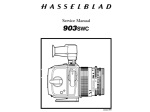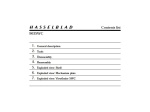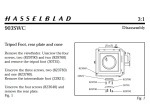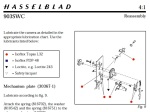Here are the Instructions / Guides / Manual you may need on How to Repair / Restore / DIY / CLEAN, LUBRICATE, AND ADJUST Hasselblad 903SWC Camera Bodies
Pictures uploaded are considered an important part of this description. Please examine carefully.
“Hasselblad 903SWC Service Manual”
Language: English
File Type: Pdf
Number of pages: 20 pages.
File Size: 0.68 mb.
The file(s) will be sent to your paypal registered email address within 3 working days (Usually I will do this within a few hours). Due to the high quality scan, some of the file sizes are very big, i.e., >10MB. We will email you a link of the file so that you can download anytime.
Any questions, please ask.
Strengths: Focusing with this camera is done one three ways.
1. You can measure the distance with a tape, ruler or…..
2. One may just hyperfocus, even wide open this lens has great depth of focus.
3. There is a veiwing system that works like a view camera.
With the above reflex system one may get a dead on framing.
By the way one also needs a tripod.
It has great viewer that fits into the flash shoe.
Weaknesses: It is slow operating camera.It will not do 5 frams per second. One must have a handheld meter or know the rule of F/16.
Bottom Line:
Second, is the element count. For the 6x6cm it has always been 8 elements in 5 groups. It is based on a large format lens, a 10 element lens. This large format lens has a larger circle of focus. That is why 6x7cm rangefinder camera uses the older 10 element lens. Is it better, maybe, never used one. But it is not better because it has more elements. Some very sharp marco lens are slow with few elements. Only a fool thinks more elements make for a sharper lens. As a matter of fact 35mm lens are enherently sharper then larger format lens.
Bottom line Hassi SWC have always the same sharp lens from day one and them boys at Carl Ziess make some of the finest lens in the world.
Deal with it SWC are one of kind and photographic jewel.
Weaknesses: My Leica rangefinders (10 bodies M1-M6, 22 lenses including 3 21mm’s) are just gathering dust – who would have thought.
Bottom Line:
What you will not get used to is the extraordinary results. Color, B&W, 50 or 3200 ISO, shot from the hip or from the tripod, whatever you do (maybe not standard portrait – I’ll give you that) the results will have you lifting your jaw off the floor. The sharpness is just breathtaking, and that nice large negative or transparency (use Velvia and the world will never have looked so good) will have you ordering 16×16 custom enlargements.
Now if I haven’t quite convinced you and you are a B&W photographer, you can get a good non-T* outfit for well under $2,000. Many people, even some dealers will tell you that while there is a difference between T* and non-T* it is a difference without consequence. But you know if you are a color user you will always have that nagging doubt in the back of your mind, so spend the extra bucks and sleep easy at night.
A friend of mine is a serious amateur who recently purchased the Contax 645 auto-focus, a bunch of lenses, backs, etc. for around $10,000. After looking at my Velvia transparencies, she is rethinking her decision. She wanted auto-focus, but may now be willing to live without it. She wanted interchangable lenses, but is now …
Full Specification:
| Film Format: | 6 x 6 cm and 6 x 4.5 cm with different magazines. |
| Film Choices: | 120 and 220 roll films. 70mm perforated long rolls, sheet film and Polaroid film. |
| Lens: | Carl Ziess Biogon CF 38mm f/4.5 T* true wide-angle lens with 90° diagonal (72° horizontal) angle of view and 60 mm front bayonet mount. |
| View-finder: | Detachable optical view-finder with built-in sprit level and built-in magnifier for reading lens scales through the view-finder. A focusing screen adapter, which is attached to the camera in the same way as the film magazine, is available for checking picture composition and depth of field. The adapter is used together with a focusing or magnifying hood, or a prism viewfinder, with or without a meter. |
| Focusing: | Focusing range of lens: 0.3m to infinity. Depth of field range: 3m to infinity at f/4.5 and 0.65m to infinity at f/22. |
| Shutter: | Leaf shutter in lens, 1-1/500 s and flash synchronisation at all shutter speeds. |
| Film advance: | Simultaneous manual shutter cocking and film advance. Foldable winding crank. |
| Camera body: | One-piece cast aluminium alloy shell with 1/4″ socket and plate for tripod quick coupling attachment. |
| System compatibility: | The 903SWC accepts all film magazines made for other Hasselblad models. |
| The Biogon lens mount will accept Æ 60 filters and softars | |
| Dimensions: | Camera body with lens and film magazine A12: 145 x 112 x 150 mm. |
| Weight: | Camera body with lens and film magazine A12: 1325 g. |
| Camera finish: | Available with chrome or black finished bodies. Supplied with optical view-finder,carrying strap and front and rear protective covers. |
We accept paypal only.







